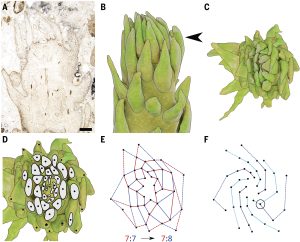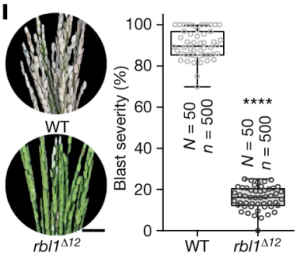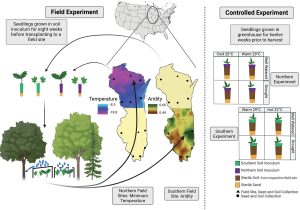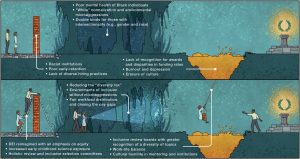Essay: The coming golden age of lichen biology
 Lichens are remarkable, complex symbiotic organisms. They have evolved multiple times independently, but all lichen include at least one fungal partner (the mycobiont) which they usually resemble morphologically, and at least one cyanobacterial or algal photosynthetic partner (the photobiont). This partnership provides environmental durability plus the power of photosynthesis, making lichen pretty ubiquitous; they can be found almost everywhere. But, as Scharnagl et al. observe, they remain poorly studied and understood. In this essay, the authors highlight the fundamental questions that remain about lichen and what might be gained from further study of these organisms. Some of the most interesting questions address how the two or more organisms recognize each other and coordinate the regulation of their genes; how much if any similarity is there with the interactions between plants and fungal pathogens? How are nutrients exchanged between partners, and what can be learned from lichen’s tolerance of extreme environments? The authors conclude with a “call to arms”, encouraging researchers to participate in addressing these and other fundamental questions about lichen biology. (Summary by Mary Williams @PlantTeaching) Curr. Biol. 10.1016/j.cub.2023.03.054 (See also the rest of this special issue on Plant Interactions https://www.cell.com/issue/S0960-9822(22)X0012-2).
Lichens are remarkable, complex symbiotic organisms. They have evolved multiple times independently, but all lichen include at least one fungal partner (the mycobiont) which they usually resemble morphologically, and at least one cyanobacterial or algal photosynthetic partner (the photobiont). This partnership provides environmental durability plus the power of photosynthesis, making lichen pretty ubiquitous; they can be found almost everywhere. But, as Scharnagl et al. observe, they remain poorly studied and understood. In this essay, the authors highlight the fundamental questions that remain about lichen and what might be gained from further study of these organisms. Some of the most interesting questions address how the two or more organisms recognize each other and coordinate the regulation of their genes; how much if any similarity is there with the interactions between plants and fungal pathogens? How are nutrients exchanged between partners, and what can be learned from lichen’s tolerance of extreme environments? The authors conclude with a “call to arms”, encouraging researchers to participate in addressing these and other fundamental questions about lichen biology. (Summary by Mary Williams @PlantTeaching) Curr. Biol. 10.1016/j.cub.2023.03.054 (See also the rest of this special issue on Plant Interactions https://www.cell.com/issue/S0960-9822(22)X0012-2).
Going against the botanical grain: Early leafy plants have unique non-Fibonacci spirals in their leaves and sporangia
 This study by Turner et al. looks at the patterns of leaf and sporangia arrangement in early leafy plant species, questioning the widely held idea that these structures follow the Fibonacci sequence. The researchers investigated fossilized remains from the Early Devonian period. To evaluate the spatial arrangement of leaves and sporangia in fossilized specimens, they used high-resolution imaging techniques, digital analysis, and mathematical modeling, which uncovered remarkable non-Fibonacci spiral patterns. This finding begs the question of what evolutionary variables influence plant growth and development. To explain the prevalence of non-Fibonacci spirals in early leafy plants, several possibilities have been advanced, including genetic variances, environmental factors, and the potential of unique development mechanisms in ancient plant lineages. More study and comparison studies are needed, however, to delve deeper into the fundamental mechanisms that drive spiral patterns in plant morphology. This study not only adds to our understanding of the development of leafy plants, but it also calls into question the prevailing wisdom about the ubiquity of Fibonacci spirals in natural structures and emphasizes the importance of gaining a more comprehensive knowledge of the principles that have guided plant growth and development throughout time. (Summary by Arpita Yadav @arpita_yadav_). Science 10.1126/science.adg4014
This study by Turner et al. looks at the patterns of leaf and sporangia arrangement in early leafy plant species, questioning the widely held idea that these structures follow the Fibonacci sequence. The researchers investigated fossilized remains from the Early Devonian period. To evaluate the spatial arrangement of leaves and sporangia in fossilized specimens, they used high-resolution imaging techniques, digital analysis, and mathematical modeling, which uncovered remarkable non-Fibonacci spiral patterns. This finding begs the question of what evolutionary variables influence plant growth and development. To explain the prevalence of non-Fibonacci spirals in early leafy plants, several possibilities have been advanced, including genetic variances, environmental factors, and the potential of unique development mechanisms in ancient plant lineages. More study and comparison studies are needed, however, to delve deeper into the fundamental mechanisms that drive spiral patterns in plant morphology. This study not only adds to our understanding of the development of leafy plants, but it also calls into question the prevailing wisdom about the ubiquity of Fibonacci spirals in natural structures and emphasizes the importance of gaining a more comprehensive knowledge of the principles that have guided plant growth and development throughout time. (Summary by Arpita Yadav @arpita_yadav_). Science 10.1126/science.adg4014
Plant stem cells under low oxygen: metabolic rewiring by phytoglobin underlies stem cell functionality
 When flooding occurs, soils become saturated and oxygen solubility and diffusion decreases. This situation creates a hypoxic environment in the roots that stresses the plant, causing significantly decreased growth. However, the quiescent center (QC) stem cells, located in the root apical meristem, are highly hypoxic under normal oxygen tension. When hypoxia is imposed to the roots, QC stem cells become vulnerable, causing their degradation. The effects of the QC degradation have been ascribed to the accumulation of nitric oxide (NO), since overexpression of phytoglobins (Pgb) (which scavenge NO) preserved the functionality of the QC cells. In this work, Mira et al. described carbon/nitrogen metabolism in the QC stem cells under low oxygen. To study this, they dissected maize QC stem cells and conduced multi-omic analysis. These analyses shed light into how the QC cells are metabolically, proteomically, and transcriptomically reprogrammed in response to hypoxia. This work demonstrates that root stem cells are vulnerable to low oxygen stress and the preservation of QC stem cells is linked with engagement of the TCA cycle and the action of a phytoglobin-encoding gene ZmPgb1.1 and the retention of carbohydrates and starch. (Summary by Eva Maria Gomez Alvarez, @eva_ga96) Plant Physiology. 10.1093/plphys/kiad344
When flooding occurs, soils become saturated and oxygen solubility and diffusion decreases. This situation creates a hypoxic environment in the roots that stresses the plant, causing significantly decreased growth. However, the quiescent center (QC) stem cells, located in the root apical meristem, are highly hypoxic under normal oxygen tension. When hypoxia is imposed to the roots, QC stem cells become vulnerable, causing their degradation. The effects of the QC degradation have been ascribed to the accumulation of nitric oxide (NO), since overexpression of phytoglobins (Pgb) (which scavenge NO) preserved the functionality of the QC cells. In this work, Mira et al. described carbon/nitrogen metabolism in the QC stem cells under low oxygen. To study this, they dissected maize QC stem cells and conduced multi-omic analysis. These analyses shed light into how the QC cells are metabolically, proteomically, and transcriptomically reprogrammed in response to hypoxia. This work demonstrates that root stem cells are vulnerable to low oxygen stress and the preservation of QC stem cells is linked with engagement of the TCA cycle and the action of a phytoglobin-encoding gene ZmPgb1.1 and the retention of carbohydrates and starch. (Summary by Eva Maria Gomez Alvarez, @eva_ga96) Plant Physiology. 10.1093/plphys/kiad344
Genome editing to enhance broad-spectrum disease resistance in rice without compromising yield
 Developing broad-spectrum disease resistant crops without compromising yield has been a persistent challenge in maintaining global food security. In a breakthrough study, Sha et al. developed a promising multi-pathogen resistant rice mutant that retains the crop’s yield, using forward genetic screen and genome editing approaches. The research journey began with the identification of a group of lesion mimic mutants (LMM) from a mutagenized rice population. Among these, a mutant named resistance to blast1 (rbl1) displayed resistance to both fungal and bacterial pathogens but had the drawback of low fertility and yield. The causal mutation was mapped to be a 29-bp deletion in the RBL1 gene, encoding for the CDP-DAG synthase (CDS). CDP-DAG is a precursor for phosphatidylinositol (PI) and its downstream products PI3P, PI4P, and PI(4,5)P2. The rbl1 mutation led to a decrease of PI(4,5)P2, a key player in fungal-plant interactions. To engineer a rbl1 allele without yield loss, Sha et al. strategically applied genome editing to target different sites of RBL1. They successfully identified a new allele, rbl1△12, carrying a 12-bp deletion. Impressively, rbl1△12 not only demonstrated resistance to a range of fungal and bacterial pathogens, but also maintained wild-type yield in small-scale field trial. This study represents a significant step forward in the quest for durable disease-resistant crops. (Summary by Xiaohui Li @Xiao_hui_Li) Nature 10.1038/s41586-023-06205-2
Developing broad-spectrum disease resistant crops without compromising yield has been a persistent challenge in maintaining global food security. In a breakthrough study, Sha et al. developed a promising multi-pathogen resistant rice mutant that retains the crop’s yield, using forward genetic screen and genome editing approaches. The research journey began with the identification of a group of lesion mimic mutants (LMM) from a mutagenized rice population. Among these, a mutant named resistance to blast1 (rbl1) displayed resistance to both fungal and bacterial pathogens but had the drawback of low fertility and yield. The causal mutation was mapped to be a 29-bp deletion in the RBL1 gene, encoding for the CDP-DAG synthase (CDS). CDP-DAG is a precursor for phosphatidylinositol (PI) and its downstream products PI3P, PI4P, and PI(4,5)P2. The rbl1 mutation led to a decrease of PI(4,5)P2, a key player in fungal-plant interactions. To engineer a rbl1 allele without yield loss, Sha et al. strategically applied genome editing to target different sites of RBL1. They successfully identified a new allele, rbl1△12, carrying a 12-bp deletion. Impressively, rbl1△12 not only demonstrated resistance to a range of fungal and bacterial pathogens, but also maintained wild-type yield in small-scale field trial. This study represents a significant step forward in the quest for durable disease-resistant crops. (Summary by Xiaohui Li @Xiao_hui_Li) Nature 10.1038/s41586-023-06205-2
Shifting microbial communities can enhance tree tolerance to changing climates
 Like all of Earth’s lifeforms, plants are already experiencing hardships due to the changing climate, and these stresses will get more extreme. Much effort has gone into breeding crops for climate resilience, less on trees which are both more diverse and less genetically tractable. Here, Allsup et al. provide an interesting approach to enhance tree tolerance to climate change, by altering their soil microbial communities. Previous studies have demonstrated that specific microbiomes can enhance plant stress resilience. In this study, the authors collected soil from 12 sites across two states (Wisconsin and Illinois), then used these to inoculate tree seedings of several species. The seedlings were transplanted to a northern (colder, wetter) field site or a southern (hotter, drier) field site, or grown in a greenhouse. Interestingly, inoculation with soil from drier sources conferred an advantage to the seedlings planted in the drier, more southerly site. In the northerly site under ambient rainfall conditions, seedling survival was optimized by preinoculation with microbial communities from colder sites. Although the authors say that “Intentional inoculation of specific microbial taxa into forests is not feasible at scale,” they do point out that most planted trees start their lives in nurseries, where it would be entirely feasible to provide them with a microbial cocktail designed to enhance their survival in their future home. (Summary by Mary Williams @PlantTeaching) Science 10.1126/science.adf2027
Like all of Earth’s lifeforms, plants are already experiencing hardships due to the changing climate, and these stresses will get more extreme. Much effort has gone into breeding crops for climate resilience, less on trees which are both more diverse and less genetically tractable. Here, Allsup et al. provide an interesting approach to enhance tree tolerance to climate change, by altering their soil microbial communities. Previous studies have demonstrated that specific microbiomes can enhance plant stress resilience. In this study, the authors collected soil from 12 sites across two states (Wisconsin and Illinois), then used these to inoculate tree seedings of several species. The seedlings were transplanted to a northern (colder, wetter) field site or a southern (hotter, drier) field site, or grown in a greenhouse. Interestingly, inoculation with soil from drier sources conferred an advantage to the seedlings planted in the drier, more southerly site. In the northerly site under ambient rainfall conditions, seedling survival was optimized by preinoculation with microbial communities from colder sites. Although the authors say that “Intentional inoculation of specific microbial taxa into forests is not feasible at scale,” they do point out that most planted trees start their lives in nurseries, where it would be entirely feasible to provide them with a microbial cocktail designed to enhance their survival in their future home. (Summary by Mary Williams @PlantTeaching) Science 10.1126/science.adf2027
A closer look at the pigmentation patterns of those South African daisies, Gorteria diffusa
 Recently, we highlighted a sexually deceptive daisy that mimics a female bee-fly to attract the male pollinators. In a recent preprint, Fattorini et al. take a closer look at the factors that specify the petal pigmentation pattern. The authors looked at three morphotypes with different spot patterns, colors, and frequencies. The authors used mass-spectrometry to identify the pigments, and found that the major pigment in the spots are malonylated anthocyanins; malonic acid acylation is thought to contribute to anthocyanin stability. Building on prior studies, the authors investigated candidate R2-R3 MYB transcription factors and identified three that are specifically correlated with anthocyanin production in the petal spots. Additional studies demonstrated that these transcription factors can induce anthocyanin production in a heterologous host, and bind to genes encoding pigment biosynthetic genes, specifically GdANS and GdDFRs, as well as a gene encoding malonyl transferase (GdMAT1). Stay tuned for more insights into the development and evolutionary foundations of this interesting daisy. Summary by Mary Williams @PlantTeaching) bioRxiv 10.1101/2023.02.20.529304
Recently, we highlighted a sexually deceptive daisy that mimics a female bee-fly to attract the male pollinators. In a recent preprint, Fattorini et al. take a closer look at the factors that specify the petal pigmentation pattern. The authors looked at three morphotypes with different spot patterns, colors, and frequencies. The authors used mass-spectrometry to identify the pigments, and found that the major pigment in the spots are malonylated anthocyanins; malonic acid acylation is thought to contribute to anthocyanin stability. Building on prior studies, the authors investigated candidate R2-R3 MYB transcription factors and identified three that are specifically correlated with anthocyanin production in the petal spots. Additional studies demonstrated that these transcription factors can induce anthocyanin production in a heterologous host, and bind to genes encoding pigment biosynthetic genes, specifically GdANS and GdDFRs, as well as a gene encoding malonyl transferase (GdMAT1). Stay tuned for more insights into the development and evolutionary foundations of this interesting daisy. Summary by Mary Williams @PlantTeaching) bioRxiv 10.1101/2023.02.20.529304
Juneteenth in STEMM and the barriers to equitable science
 Recently, the United States designated Juneteenth as a new federal holiday, which celebrates freedom of the last large body of enslaved Black Americans following the American Civil War. However, the impact of chattel slavery persists: Black scientists face many obstacles to attaining an education and persisting in the fields of science, technology, engineering, mathematics, and medicine (STEMM). In this Commentary by Mays et al., 52 Black scientists establish the context of Juneteenth in STEMM and discuss the barriers Black scientists face, the struggles they endure, and the lack of recognition they receive. They review racism’s history in science and provide institutional-level solutions to reduce the burdens on Black scientists. Specific recommendations include increasing recognition of the value of and labor involved in supporting students through mentoring, greater representation of people of marginalized identities in positions of power including review and editorial boards, and cultural humility in mentoring and institutions. (Summary by Mary Williams @PlantTeaching) Cell 10.1016/j.cell.2023.05.016
Recently, the United States designated Juneteenth as a new federal holiday, which celebrates freedom of the last large body of enslaved Black Americans following the American Civil War. However, the impact of chattel slavery persists: Black scientists face many obstacles to attaining an education and persisting in the fields of science, technology, engineering, mathematics, and medicine (STEMM). In this Commentary by Mays et al., 52 Black scientists establish the context of Juneteenth in STEMM and discuss the barriers Black scientists face, the struggles they endure, and the lack of recognition they receive. They review racism’s history in science and provide institutional-level solutions to reduce the burdens on Black scientists. Specific recommendations include increasing recognition of the value of and labor involved in supporting students through mentoring, greater representation of people of marginalized identities in positions of power including review and editorial boards, and cultural humility in mentoring and institutions. (Summary by Mary Williams @PlantTeaching) Cell 10.1016/j.cell.2023.05.016
 This study by Turner et al. looks at the patterns of leaf and sporangia arrangement in early leafy plant species, questioning the widely held idea that these structures follow the Fibonacci sequence. The researchers investigated fossilized remains from the Early Devonian period. To evaluate the spatial arrangement of leaves and sporangia in fossilized specimens, they used high-resolution imaging techniques, digital analysis, and mathematical modeling, which uncovered remarkable non-Fibonacci spiral patterns. This finding begs the question of what evolutionary variables influence plant growth and development. To explain the prevalence of non-Fibonacci spirals in early leafy plants, several possibilities have been advanced, including genetic variances, environmental factors, and the potential of unique development mechanisms in ancient plant lineages. More study and comparison studies are needed, however, to delve deeper into the fundamental mechanisms that drive spiral patterns in plant morphology. This study not only adds to our understanding of the development of leafy plants, but it also calls into question the prevailing wisdom about the ubiquity of Fibonacci spirals in natural structures and emphasizes the importance of gaining a more comprehensive knowledge of the principles that have guided plant growth and development throughout time. (Summary by Arpita Yadav @arpita_yadav_). Science 10.1126/science.adg4014
This study by Turner et al. looks at the patterns of leaf and sporangia arrangement in early leafy plant species, questioning the widely held idea that these structures follow the Fibonacci sequence. The researchers investigated fossilized remains from the Early Devonian period. To evaluate the spatial arrangement of leaves and sporangia in fossilized specimens, they used high-resolution imaging techniques, digital analysis, and mathematical modeling, which uncovered remarkable non-Fibonacci spiral patterns. This finding begs the question of what evolutionary variables influence plant growth and development. To explain the prevalence of non-Fibonacci spirals in early leafy plants, several possibilities have been advanced, including genetic variances, environmental factors, and the potential of unique development mechanisms in ancient plant lineages. More study and comparison studies are needed, however, to delve deeper into the fundamental mechanisms that drive spiral patterns in plant morphology. This study not only adds to our understanding of the development of leafy plants, but it also calls into question the prevailing wisdom about the ubiquity of Fibonacci spirals in natural structures and emphasizes the importance of gaining a more comprehensive knowledge of the principles that have guided plant growth and development throughout time. (Summary by Arpita Yadav @arpita_yadav_). Science 10.1126/science.adg4014







 Lu Yu, co-first author of
Lu Yu, co-first author of